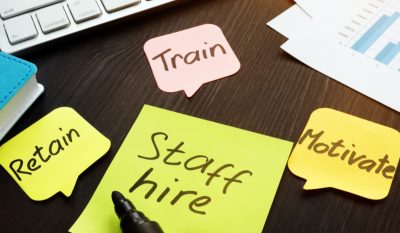Human resource is a significant part of every organization. The HR department handles many roles like employee relations, talent acquisition, payroll, onboarding, and much more. Amongst this, talent management has its significance. A well-planned talent management plan can help a company reach its goals.
Talent management is a constant cycle involving the recruitment and retention of high-quality workers, the improvement of their skills, and continuous encouragement to them to enhance their performance.
Talent management aims at creating a motivational workforce who will work in the company for a longer period.
Talent management strategies
The nature of work is continuously changing, as the Fourth Industrial Revolution (4IR) continues to disintegrate many industries with artificial intelligence (AI), robotic process automation (RPA), and machine learning (ML).
Contradicting the previous generation, millennials today are not focused on devoting much time to a single organization. Looking at such scenarios, it has become necessary to think upon workforce demographics and required skill sets, looking at the way our companies are organized and how we describe the definition of the job itself.
1. Work filled with purpose
In the coming times, the best talent would only like to work with those companies that have a clear vision. Automation of tasks has increased because of the Fourth Industrial Revolution (4IR) technologies. Thus, organizations with more promising opportunities will attract the best talent by giving employees a deeper reason for being real and performing meaningful work.
Indeed, the recent Global Talent Trends report from Mercer found that 75% of thriving employees say their business has a strong sense of purpose that resonates with their values. For managers, this means making sure employees feel satisfied with their jobs. It also calls for a straightforward, persuasive, honest, and transparent firm mission, vision, strategy, and value proposition.
2. Digital right from the core
A thorough digital workspace is what the future work will be demanding, which indicates that digital strategy should be not only a part of the Chief Digital Officer’s role but also mandatory for all roles, i.e., IT to HR to marketing to C-suite.
Digital should become an integral part of a company’s culture. Activities like virtual team meets, cloud document sharing, and project management/collaboration apps should be standard rather than an anomaly.
Managers need better, more accessible HR tech, too. To be predictive and competency-centric, human capital management (HCM) techniques for the future of work need to be improved with AI (Artificial Intelligence) and ML (Machine Learning).
3. Creating a stronger employer brand
Soon, companies will hold a fierce competition for talent, similar to what it has become for job seekers now. Such situations will compel organizations to create a likely employer brand in the market.
Managers will need to work to build a reputation for their organizations that is consistent with the corporate culture and the experience of employees across all departments: marketing, sales, IT, etc.
To attract and maintain the best talent, the business of the future will have to develop and display its corporate culture by aligning and effectively managing its brand internally and externally.
4. A new breed of leadership
Step forward needs new leadership. The employees of the future will be able to spot weak leaders much sooner and will not be willing to accept them for the sake of job security, as explained above.
Leadership is no longer about throwing headlines around. Instead, it will be about having a clear vision, articulating it to the rest of the team, and creating the right environment for the team to emerge.
Hence the best leaders must be good at:
- Exemplifying their expected behaviors
- Remote, blended, fluid team alignment
- To promote decentralized decision making
- Virtual communication (diminishing the body language and removing physical contact)
5. Outsourcing (both to humans and machines)
Managers would need to be able to find out which activities they can reorganize into freelance projects, contracts, and assignments to be worked on by internal and external talented mixed teams.
Managers will also need to find out how best to incorporate the latest technologies for the future of work, such as robots, chatbots, AIs, and predictive analytics, to empower their employees.
6. Harnessing the power of Virtual Reality (VR)
Virtual reality (VR) will be one of the most relevant workplace development devices, as virtual teamwork and remote work are the standard forms of working. Managers would need to be able to utilize their ability to provide immersive, collaborative training in real-time. Research shows that by 2022 nearly three-quarters of SMBs will be experimenting with immersive technology.
The key advantages of VR training include:
- Improved commitment – gamification elements can be easily integrated into the lessons
- More efficient teamwork – workers can be in the same virtual space at various locations
- Data-led intelligence – VR technology captures more and more in-depth data for assessment
7. Prioritizing employee experience (EX)
Companies now are trying to put more focus on user experience (UX) and customer experience (CX) for a long time. In the age of employee experience (EX), the future of work will usher in. It will require businesses to counter job stagnation and position immobility, in addition to providing substantive work, as stated earlier.
Managers would have to make space for workers to move within the company and find a new place for reinventing their skill sets. It is a perfect way to keep workers as they develop and enhance their abilities.
With workers already choosing jobs based on the amount of flexibility offered and coronavirus pushing businesses to accept remote work, permanent flexibility would be the hallmark of the future workplace.
8. Agile management
Agile is no longer just for the tech. It’s permeated into other business functions, and now the way organizations approach HR is changing.
In a Deloitte survey in 2017, 79% of global executives rated agile performance management as a high organizational priority.
As companies adopt agile methods in their HR management policies, frequent performance assessments (preferably project-by-project) should be given rather than the annual performance review. Managers do need to make room for peer-to-peer input, as well as “upward” feedback from workers to team members.
So as far as compensation goes, managers would need to award incentives for excellent on-the-spot results rather than wait till the end of the year. Studies and experience have shown that reward functions better as a motivator when instantly given as soon as the tasks get completed.
Inference
Upgrading company norms as per the needs of the changing styles of working for sure would lead to acquiring the best results not only for the organization but will also provide a convenient way for employees to work. Applying the above-said strategies will help all corporate firms operate more smoothly. For more such content on talent management, you may access our latest whitepapers on Talent Management.











